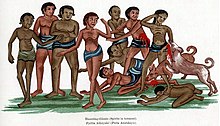
Back প্ৰেত Assamese প্রেত Bengali/Bangla ཡི་དྭགས་ Tibetan Preta Catalan Préta Czech Pretao Esperanto Preta Spanish Preeta Estonian Preta French Préta Hungarian
This article needs additional citations for verification. (October 2008) |
 A Burmese depiction of hungry ghosts (pyetta). | |
| Grouping | Legendary creature |
|---|---|
| Sub grouping | Nocturnal, revenant |
| Similar entities | Ancestor spirits, krasue |
| Folklore | Indian religions Chinese folk religion Taoism Vietnamese folk religion |
| Other name(s) | Hungry ghost |
| Region | East, South and Southeast Asia |
| Habitat | Hinduism shmashanas or cemetery Buddhism Hungry Ghost Realm |
| Translations of Preta | |
|---|---|
| Pali | पेत (peta) |
| Burmese | ပြိတ္တာ (MLCTS: peiʔtà) |
| Chinese | 餓鬼 (Pinyin: Èguǐ) |
| Japanese | 餓鬼 (Rōmaji: Gaki) |
| Khmer | ប្រេត (UNGEGN: Praet) |
| Korean | 아귀 (RR: Agui) |
| Lao | ເຜດ (/pʰèːt/) |
| Mon | ပြိုတ် ([[prɒt]]) |
| Mongolian | ᠪᠢᠷᠢᠳ (birid) |
| Shan | ၽဵတ်ႇ ([phet2]) |
| Sinhala | ප්රේත (pretha) |
| Tibetan | ཡི་དྭགས་ (yi dwags) |
| Tagalog | Pleta |
| Thai | เปรต (RTGS: pret) |
| Vietnamese | ngạ quỷ |
| Glossary of Buddhism | |
Preta (Sanskrit: प्रेत, Standard Tibetan: ཡི་དྭགས་ yi dags), also known as hungry ghost, is the Sanskrit name for a type of supernatural being described in Hinduism, Buddhism, Taoism, and Chinese folk religion as undergoing suffering greater than that of humans, particularly an extreme level of hunger and thirst.[1] They have their origins in Indian religions and have been adopted into East Asian religions via the spread of Buddhism. Preta is often translated into English as "hungry ghost" from the Chinese and East Asian adaptations. In early sources such as the Petavatthu, they are much more varied. The descriptions below apply mainly in this narrower context. The development of the concept of the preta started with just thinking that it was the soul and ghost of a person once they died, but later the concept developed into a transient state between death and obtaining karmic reincarnation in accordance with the person's fate.[2] In order to pass into the cycle of karmic reincarnation, the deceased's family must engage in a variety of rituals and offerings to guide the suffering spirit into its next life.[2] If the family does not engage in these funerary rites, which last for one year, the soul could remain suffering as a preta for the rest of eternity.[2]
Pretas are believed to have been false, corrupted, compulsive, deceitful, jealous or greedy people in a previous life. As a result of their karma, they are afflicted with an insatiable hunger for a particular substance or object. Traditionally, this is something repugnant or humiliating, such as cadavers or feces, though in more recent stories, it can be anything, however bizarre.[3] In addition to having insatiable hunger for an aversive item, pretas are said to have disturbing visions.[4] Pretas and human beings occupy the same physical space and while humans looking at a river would see clear water, pretas see the same river flowing with an aversive substance; common examples of such visions include pus and filth.[4]
Through the belief and influence of Hinduism and Buddhism in much of Asia, preta figure appear prominently in the cultures of India, Bangladesh, Sri Lanka, China, Japan, Korea, Vietnam, Tibet, Thailand, Cambodia, Laos and Myanmar.
- ^ Mason, Walter (2010). Destination Saigon: Adventures in Vietnam. ISBN 9781459603059.
- ^ a b c Krishan, Y. (1985). "The Doctrine of Karma and Śrāddhas". Annals of the Bhandarkar Oriental Research Institute. 66 (1/4): 97–115. ISSN 0378-1143. JSTOR 41693599.
- ^ Garuda Purana 2.7.92-95, 2.22.52-55
- ^ a b Tzohar, Roy (2017). "Imagine Being a Preta: Early Indian Yogācāra Approaches to Intersubjectivity". Sophia. 56 (2): 337–354. doi:10.1007/s11841-016-0544-y. S2CID 171169300.
© MMXXIII Rich X Search. We shall prevail. All rights reserved. Rich X Search